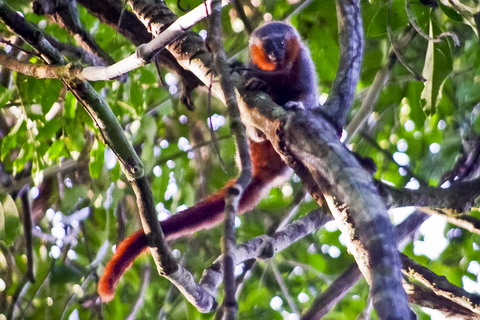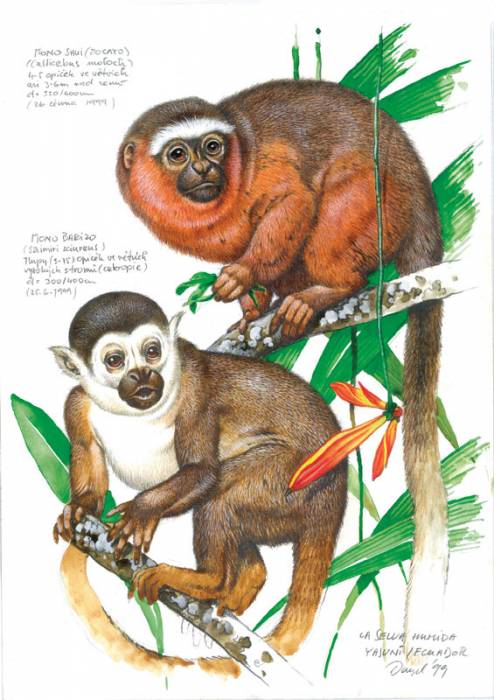New Amazon Monkey Discovered
Posted by: Loren Coleman on August 25th, 2011

Scientists on an expedition backed by WWF-Brazil to one of the last unexplored areas in the Brazilian Midwest have discovered a new species of monkey.
The monkey belonging to the Callicebus genus was found in the northwest of Mato Grosso State and is one of the great results from the studies undertaken during an expedition in December 2010 to the Guariba-Roosevelt Extractive Reserve.

These types of monkeys are commonly called Titi. Above a titi is compared to a squirrel monkey by artist Jan Dungel.
In May, WWF-Brazil and the scientist who made the discovery, Julio Dalponte, officially handed over the specimen to the Emílio Goeldi Museum in Belem, Para.
“By integrating this animal to a reputable collection such as that of the Goeldi museum we have taken an important step towards gaining better knowledge of the fauna in the northwest Mato Grosso region which is still a puzzle with many pieces missing”, Mr Dalponte explained.
Dalponte remarked that the discovery of the new species increases the potential biodiversity of the northwest of Mato Grosso and with it the importance of conservation in the area.
“We do have some information on Protected Areas surrounding this region but little information on this part of the State itself. That means we must work to complete this map and fill in the gaps in our information on the region” said Dalponte.
“Never been observed before”
The primate specimen was found in an area between the courses of the Guariba River and the Roosevelt River, two of the most important water courses in the north-western part of Mato Grosso state.
Dalponte noted “This primate has features on its head and tail that have never been observed before in other titi monkey species found in the same area”.
The animal will be the object of studies designed to provide a detailed description of its characteristics to mammalian zoology experts and primatologists worldwide.
The study of the species will take about six months to conclude. The process of publishing the discovery in specialised scientific journals can take up to one year from the time the papers are submitted till the time they are approved for publication by the editing committees of scientific journals and reviews.

Photo Julio Dalponte.
About Loren Coleman
Loren Coleman is one of the world’s leading cryptozoologists, some say “the” leading living cryptozoologist. Certainly, he is acknowledged as the current living American researcher and writer who has most popularized cryptozoology in the late 20th and early 21st centuries.
Starting his fieldwork and investigations in 1960, after traveling and trekking extensively in pursuit of cryptozoological mysteries, Coleman began writing to share his experiences in 1969. An honorary member of Ivan T. Sanderson’s Society for the Investigation of the Unexplained in the 1970s, Coleman has been bestowed with similar honorary memberships of the North Idaho College Cryptozoology Club in 1983, and in subsequent years, that of the British Columbia Scientific Cryptozoology Club, CryptoSafari International, and other international organizations. He was also a Life Member and Benefactor of the International Society of Cryptozoology (now-defunct).
Loren Coleman’s daily blog, as a member of the Cryptomundo Team, served as an ongoing avenue of communication for the ever-growing body of cryptozoo news from 2005 through 2013. He returned as an infrequent contributor beginning Halloween week of 2015.
Coleman is the founder in 2003, and current director of the International Cryptozoology Museum in Portland, Maine.










Another cryptozoological success, and a cute one to boot.
Another victory for the open-minded/anti-pseudo skeptics!
They are giving this monkey to a museum for study? Did they kill this animal in order to study it?!?! I’ve certainly never been to a museum that has live animals. I’m an anthropology major in my junior year, so I’m all for study. I am certainly NOT for killing in order to study.
What an amazing monkey. I want one.
rani124
Hello:)
I don’t know if they did or not, though I agree that i’ve never seen a living animal at a museum (unless you count Zoos as museums). I don’t think it would be too difficult to capture a Titi so its possible that they may not have killed it, and its true you can learn more from a live animal than a dead one.
However, either killing or finding parts of or an already dead type specimen is how many, if not most new biological discoveries have occurred for centuries, and sometimes captivity can be worse than death (being poked, prodded, grappled with by beings wearing latex gloves, unusual surroundings, no freedom to roam over great distances, possible cruelty from some of the human staff at where ever the animal is caged or kept at, noises from other animals, many perhaps unknown to the type specimen, perhaps not even a chance to breed with a female…sounds like a nightmare for some, if not most animals. However, humane conditions and good treatment by good staff override the costs of confinement for animals). And some animals are difficult to capture alive (its one thing to haul out a new species of monkey, another to haul out a new species of African Elephant!).
People have said that they would be for discovering and researching Bigfoot, Loch Ness monsters, Chupacabras, Yowies, etc, if it didn’t involve killing one. But considering the poor track record involved with trying to research something(s) that is not proven to exist because there is no type specimen (the requirement for recognizing a new species and therefore getting real conservation measures underway) due in part to the difficulties involved combined with numerous investigators who still rely on footage, footprints, eyewitness testimony and anomalous DNA instead of obtaining a type specimen, the only way we could ever proove absolutely that these wonder beasts exist is with a type specimen, and often the best way to get one is to kill one. Its harder to capture live animals than to kill them, and time is running out…
In some cases, however, some unknown animals like the Titi can be relatively easy to capture alive and I am for that. But when it comes to other anomalous Cryptids…a body is needed soon.
I would still hope for tranquilizer, tag and release rather than an actual death. If we can track and observe them at will (GPS tag) mainstream science would have to acknowledge and catalog them, even without a physical specimen.
flame821:
I doubt that. There are so many ways Pseudo-skeptics can use to get out of learning something new that simply tagging and releasing a cryptid would not do, and I have no recollection of a new species discovered by tagging and releasing. Science demands a type specimen.
Wanted: dead or alive.
@ Hapa
I do understand what you are saying however I would hope that, considering how rare these animals appear to be (added to the fact that they may well be our closest ‘cousin’ on the planet),’ and their many ‘human-like’ qualities that perhaps researchers would come up with alternative methods of documentation.
Just because no other animal has been cataloged by biologists using a tag and release method doesn’t mean it CAN’T be done, just that it HASN’T been done yet. I would suspect that observing the animal in its natural habitat, its interactions with others of its own species and how it manipulates its environment would be more useful to a scientist. Eventually (if NAPEs live in family groups or larger troops/tribes) you will have one die and then you have a physical specimen to examine. Or maybe they bury their dead in which case it can always be dug up at a later date and examined in detail at that time.
As for skeptics not believing unless there is a dead body:
1] Screw them, we shouldn’t have to kill what appears to be a sentient form of life just because ‘they’ won’t accept anything less.
2] Many of them will continue to claim hoax even with a cadaver thrown at their feet. Or, maybe even claim its a malformed Gorilla or giant Bonobo, or Hirsute Human or what have you.
I’m not here to prove anything to them; people are entitled to their own beliefs but not their own reality. Right now we have enough circumstantial evidence for me to ‘believe’ there is a large undocumented animal roaming North America but I don’t have proof to convince someone else to believe as I do. If we can GPS the animal at will. Follow, film, observe; gather scat, fur, blood, teeth, etc. We scientifically have all we need to catalog the animal and start the process for endangered species status and protection. (entire species have been re-created by a single tooth, jaw bone or skull fragment in the fossil record)
Any tranquilized animal would need to be chipped though as I imagine if they ARE smart enough to actively evade humans they would be smart (or desperate) enough to remove a tag, even if that meant losing a fair bit of skin or ear.
Thats the problem with crypozoology, it is the researchers and expeditions that do all the legwork, then once the creature is actually discovereed, the Zoologists step in and take the acolades, not the ones who have done all of the hard work in providing the specimen and proof of its existance.
We all know lifes never fair but credit should be given where it is due.
However – on that note we are living in exciting times with more new species comming to light all the time.
Flame821
Hello 🙂
Your post in an interesting one, so my response will take a while to write down.
Alternative methods of species documentation? That’s a possible one in the future: I think when it comes to deep sea organisms that would die or who knows what if you raise them up from the depths that the primary evidence is underwater photography, but even then i think some bio samples would be taken. If not, its ironic that Bigfoot photos are subject to outright rejection no matter how convincing, yet a film of a giant underwater Jellyfish would be immediately believed. However, I don’t see such a change in species recognition methods changing anytime soon. Now a capture and release after intense study in a lab (i.e. samples of blood (DNA storage), sperm or ovaries (depending on gender), hair, flesh samples, all of which could be used for cloning a specimen for continual study) might just work, but capturing a Sasquatch would most likely prove farm more difficult than bringing one down. I still think the best way is to shoot one, but maybe in the future something like that could be undertaken. However, I think such belief in a “capture and release” would continue to keep people from properly trying to document Sasquatch using tried and tested methods of species documentation (getting a body). We could do in the big fellow by sympathy.
“Screw them. We shouldn’t have to kill what appears to be a sentient form of life just because “they” wont accept anything less.”
I understand. I hate to kill animals just to prove them, But I see no other way of doing it than either shooting one or capturing it and subjecting it to the rest of its life in a lab and or a Zoo. And plus some of those Pseudo skeptics would no doubt make up the boys and girls who allow Taxonomic recognition. This is not to say that the vast majority or even almost all of those boys and girls are Pseudo skeptics, but they can be pressured and or influenced by the know-nothing elites out there, and can only be able to activate the Taxonomy meter by means of a type specimen. Grover krantz himself grew tired of the debate, wanting the search to end with a discovery: Sad he died without seeing it.
“Many of them will continue to claim hoax even with a cadaver thrown at their feet. Or maybe even claim its a malformed Gorilla or giant Bonobo, or hirstute human or what have you.”
I read something similar in a book called “Age of Zeus”: Its about these beings professing to be the Greek gods and heroes taking over the world and removing all militaries. I won’t spoil the book for you (good read despite the ultra Graphic sexual imagery in some chapters, and the cussing, both of which angered me to no end while I read it. Some things should just be left to imagination for crying out loud!), but in one scene Hercules brings out a New York Sewer Gator, a Big one, only to have skeptical people later think that, since they were gods, they could have transported an alligator there and made it of enormous size. My recollection is a little fuzzy on that scene afterwards, but is illustrative of your point.
Pseudo skeptics might try to explain away a body as a genetic Chimera run amok from a lab (Genetic or Biological Chimeras, if you don’t know, are animals altered before birth to have a characteristic or two of another unrelated organism, i.e. mice with human brain tissue, pigs with human blood, goats that shoot spider silk instead of milk out of their teats. A Humanzee is not impossible, and for all we know might have been made somewhere in the world without general knowledge. A man in Russia tried to make man-apes the old fashioned way (artificial insemination of female chimps with human sperm, and a Russian woman volunteer to be impregnated by Orangutan sperm. The former didn’t work, the latter was unable to work due to Orangutan’s death of old age, before the experiment could be carried out. Nowadays they could make such hybrids and far stranger ones through the use of techniques to make Bio-Chimeras. The Movie “Splice”is based on that possibility).
If they do, my answer is the same as Bush Jr’s was to the terrorists Bring’ em on! Without evidence to back up their claims (the burden of proof would MIGHTILY be on their shoes with such a discovery), they would look like the flat-earthers of the modern world, the know-nothing academic tyrants who deserve laughter instead of praise. Though such bio chimera-ism will have to be considered after such a body is found, if skeptics keep trying to wiggle their way out of this discovery though outlandish explanations, then they will make themselves look like charlatans of anti-discovery.
BTW: Not meant to judge on that last post. Its just that trying to assail such a discovery in ways that are not done with other discoveries (Saola, Bili Ape, etc0 would make these Pseudo skeptics appear unusual, strange, and not objective. Sorry if i was judgmental in my tone.
Flame821:
The idea of a tracking chip is something that should be considered: even Humboldt squid are smart enough to try and take underwater cameras off of fellow Humboldts that have such cameras on them.
Now you mention teeth: That would be a mind blowing discovery. That would be on part with the Denisovans, who were discovered through finger bones and i believe also a tooth. Though such miniscule fragments must be thoroughly investigated before conclusions are made (Nebraska man was known from a tooth: turned out to be a prehistoric Pig’s tooth), a tooth might be enough to prove Sasquatch. More stool also needs collecting. There is also a browridge found in mexico that looks like that of a Homo-Erectus: That bone is going under the scope, i’d bet, and it might be a decade before the final results are sent out, but that alone might be proof of Bigfoot (or a American Homo Erectus, an equally perplexing find). A tooth or teeth would be a titanic breakthrough, and you could avoid killing one if you found such teeth as remains (enamel is tougher than bone, and could survive the acidic nature of Pacific Northwest soils longer than bones could. However, they are smaller than most bones, and would be difficult to find), but after such a find, even if a new taxonomy is christened, if Bigfoot is recognized, a specimen will eventually be tracked down and shot. Science will really have to get off its high horse and prominent fat rear and actually do real work when it comes to this cryptid (Only a few do so now, such as Meldrum and Bindergnagel, though I doubt I spelled the last name correctly), and that work will entail getting a type specimen, living or dead.
In the above Hapa/Flame821 discussion, I have to come down on the side of the latter.
(Glad to see such a discussion; they’re too rare on here.)
The skeptics on this topic simply have zero scientific ammunition. Nothing needs be done to satisfy them; mainstream science is what/who needs to be satisfied. I personally – along with Flame821, apparently – think that there is more than enough information already on the table to spark serious scientific effort. Which, given modern tools, almost certainly does not require a body, which will be in scientific hands soon enough after the discovery anyway.
Once a serious scientific effort is made, what the skeptics think of this won’t matter.
Hapa: you were close on Bindernagel. Just skip the first ‘g.’